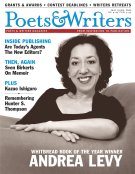Most creative writers will never get the chance to read their work to a throng of adoring fans at the 92nd Street Y in New York City or the Poetry Center of Chicago. But thanks to a growing trend in grassroots marketing and publicity, writers in the San Francisco Bay area are reading to packed houses—literally. While they don’t offer the prestige of some cultural institutions, private homes have become venues for readings by both well-known and emerging writers.
The appeal of a more intimate reading experience has even led some organizations to jump on the bandwagon.
The trend seems to be most prevalent in cities with relatively few venues to accommodate a high population of writers. In San Francisco, for example, the legendary City Lights Bookstore, which hosts only a couple events a week, receives a daily onslaught of calls from writers. “It’s insane,” says Peter Maravelis, City Lights events coordinator. “I get about thirty [requests] a day.”
But writers aren’t turning to house readings merely out of necessity. Many of them prefer the ease and familiarity that a house reading offers. “I attend a lot of readings, and all of them are valuable in one way or another, but the locations of many can be cold and institutional. Those spaces serve to increase the already awkward social relations between many poets,” says Stephanie Young, a poet who started a monthly reading series in her Oakland home in the summer of 2003. Featured readers in Young’s series have included Kevin Killian, a poet and the coauthor of Poet Be Like God: Jack Spicer and the San Francisco Renaissance (Wesleyan University Press, 1998), and Gary Sullivan, whose poetry collection How to Proceed in the Arts was published by Faux Press in 2001.
Young, who e-mails invitations to a list of 100 people and posts information about the readings on her blog (stephanieyoung.durationpress.com), says approximately 30 people attend each event. “By now I have this core group of people who always come; there’s a kind of camaraderie that comes into it,” she says. A typical event includes a potluck dinner and a reading, followed by a party. “It’s such a different feeling—nobody’s doing this for money,” says Young, who does not charge an admission fee or pay her readers.
“I think it’s less of a business arrangement than you would have at another venue,” says poet Kelly Holt, who started a readings series at her house in San Francisco in June 2004. “There’s a sense of hospitality that I like.” Her monthly series has included readings by poets Bernadette Mayer, the author of over 15 books of poetry, including A Bernadette Mayer Reader (New Directions, 1992); and Jennifer Moxley, whose poetry collections include Imagination Verses (Tender Buttons, 1996) and Often Capital (Flood Editions, 2004). Holt, who often pairs a local, younger writer with a more established writer, sends an e-mail announcement to a list of 20, asking recipients to forward the message. Holt says she hosts between 15 and 40 people at each reading.
“I think the house readings avail a certain intimacy and a better kind of space for conversation between reader and audience, even in the process of reading,” says Holt. “There’s a certain warmth in the floorboards after a poetry reading.”
Melissa Benham and Chana Morgenstern launched the monthly Artifact reading series in their Mission District home last November to bring together experimental writers from across the country. “We knew all these writers who were into different scenes and really felt a lack of community,” says Benham. In the past six months, the series has included readings by poets from the New College in San Francisco, Naropa University in Boulder, Colorado, and other literary communities.
While many successful house readings are being held in California, the trend is not limited to the West Coast. Daniel Solon, a playwright and volunteer coordinator at Housing Works Bookstore in New York City, has been hosting regular readings of plays in his apartment in Crown Heights, Brooklyn, since he moved there last June. “There are a lot of venues in the city, but I think it’s just cozier to do it in my own apartment,” Solon says. The readings are often so cozy—as many as 35 people fill the two-bedroom apartment—that Solon labels them BYOC (Bring Your Own Chair).
The appeal of a more intimate reading experience has even led some organizations to jump on the bandwagon. In January, the Loft Literary Center, a 30-year-old Minneapolis-based nonprofit organization, hosted a fundraiser during which twenty $30 tickets for a house reading with authors Judith Guest, R.D. Zimmerman, and Ellen Hart were auctioned. A member of the Loft’s board of directors, Sven Wehrwein, opened up his home in Lake Harriett for the event. “As a director of the Loft, I was trying to make a contribution, trying to offer something that they were not otherwise able to offer,” Wehrwein says. “A reading at home would be more intimate, would be comfortable, and therefore would be a great draw—people will write a check for that kind of experience.”
Wehrwein, for one, sees the house reading as an opportunity to expose people to literature who would typically not attend a more formal literary event. He says a highlight of the evening in Minneapolis was that his 16-year-old son could participate. “He was fascinated.”
Anna Mantzaris is a journalist in San Francisco.









